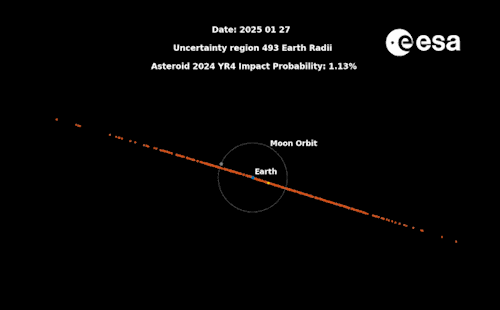Curate, connect, and discover
Asteroid - Blog Posts
Влияние астероида сделало Землю нежилой для динозавров
На протяжении десятилетий ученые не могли прийти к выводам, какая причина - массовое извержение вулканов или падение гигантского астероида - или обе сразу - привели к вымиранию огромных динозавров примерно 66 миллионов лет назад.
Cейчас свидетельства геологических раскопок и данные про естественную среду обитания динозавров утверждают, что вулканы были ни при чем. Динозавры были уничтожены холодной зимой, которая длилась десятилетиями.
Некоторым территориям в Индии удалось избежать негативных эффектов долгой зимы из-за того, что там были вулканы, которые нагревали атмосферу, и это позволило выжить некоторым видам млекопитающих, и дать им шанс на дальнейшее развитие.

Как утверждают исследователи, примерно 75 процентов всех видов растений и животных Земли исчезли очень быстро по окончанию мелового периода. Гигантский удар астероида на территории нынешнего полуострова Юкатан в Мексике, выделил достаточно пепла, пыли и газов, чтобы заблокировать Солнце и резко охладить планету в течение длительного периода времени. Это,вероятнее всего, и стало причиной массового вымирания видов. В это время в атмосферу попало огромное количество изменяющих климат газов, и вулканы выпустили сотни тысяч кубических километров лавы. Все эти явления стали причиной массового вымирания видов в конце Пермского периода 252 миллиона лет назад. После удара астероида наступила зима, во время которой температура воздуха понизилась до -30 и -40 градусов по Цельсию. Температура не могла измениться существенно как минимум 20 лет. Ситуацию немного улучшили извержения вулканов. К сожалению, влияние вулканов не смогло улучшить ситуацию для динозаров, и отменить эффект от падения астероида, но благодаря ему смогли выжить и развиваться млекопитающие.

First steps! Looking forward to contributing to the NASA Psyche Mission in the future! @nasapsyche #nasa #nasapsyche #space #asteroid #arizonastateuniversity #nasajpl https://www.instagram.com/p/B--pjChHW8Q/?igshid=o2p8g1zredsy

Had fun marking every single crater, boulder, and rock in images taken as part of the OSIRIS-REx Mission. Can’t wait for a sample of Bennu to be headed to Earth soon. #bennu #osirisrex #space #asteroid #nasa https://www.instagram.com/p/B4L43ncHzWk/?igshid=1y15577s74bmf

International Asteroid Day aims to raise public awareness about the asteroid impact hazard and to inform the public about the crisis communication actions to be taken at the global level in case of a credible near-Earth object threat. . . . . . . #asteroid #universe #space #spacetime #astronomy #astronomer #spacestation #spacetravel #sunrise #satellite https://www.instagram.com/p/CCDuhL2DN0Z/?igshid=5vxzze8zzajg
Makes me think how vulnerable we really are,,, considering how we still haven't observed any aliens yet and how they might as well not exist, life is really precious, but it can be destroyed at any moment,,
The site of impact from the asteroid that killed the dinosaurs 66 million years ago is called Chicxulub Crater
The center of the crater is located near the Mexican town of Chicxulub, after which the crater is named. The crater is larger than 180 km in diameter; this feature makes it one of the largest confirmed impact structures on Earth. The meteorite that formed the crater was at least 10 km in diameter.

The age of the rocks shows that this impact structure dates back to the end of the Cretaceous period, about 65 million years ago.


The impact associated with the crater is implicated in the extinction of dinosaurs, as suggested by the Cretaceous-Paleogene boundary (K-Pg boundary), the geological boundary between the Cretaceous and Paleogene periods, although some critics argue that the impact was not the only reason, others debate whether there was a single impact or whether the Chicxulub impact was one of several that could have hit the Earth at about the same time.
Recent data suggest that the impact may have been created by a piece of a much larger asteroid, which fragmented into a distant space collision more than 160 million years ago.
The car that hit the Earth had an estimated diameter of 10 km, and emitted an estimated equivalent of 96 teratons of TNT. By contrast, the most powerful explosive device ever detonated by man, the Tsar's Bomb, had a yield of only 50 megatons of TNT so the impact of Chicxulub is 2 million times higher and stronger.
https://player.vimeo.com/video/108650530?title=0&byline=0&portrait=0
Wanderers - a short film by Erik Wernquist
1998 or2 tracking via my Telescope

Psyche (spacecraft) over Psyche (asteroid)
(CNN) On October 19, the Pan-STARRS 1 telescope in Hawaii spotted something strange zooming through our solar system. It turned out to be a visitor from beyond our solar system, and it's unlike anything astronomers have seen before.

Prima immagine di OSIRIS-REx dallo spazio profondo, giunta a noi terrestri il 15 febbraio 2017, dopo cinque mesi di "crociera". Se state per dire che l'immagine è sfocata, sappiate che la sonda si trova a 673 milioni di km da Giove. - During Earth-Trojan asteroid search operations, the PolyCam imager aboard NASA’s OSIRIS-REx spacecraft captured this image of Jupiter (center) and three of its moons, Callisto (left), Io, and Ganymede. The image, which shows the bands of Jupiter, was taken at 3:34 a.m. EST, on Feb. 12, when the spacecraft was 76 million miles (122 million kilometers) from Earth and 418 million miles (673 million kilometers) from Jupiter. PolyCam is OSIRIS-REx’s longest range camera, capable of capturing images of the asteroid Bennu from a distance of two million kilometers.
This image was produced by taking two copies of the same image, adjusting the brightness of Jupiterandnbsp;separately from theandnbsp;significantly dimmer moons, and compositing them back together so that all four objects are visible in the same frame.
NASA’s Goddard Space Flight Center in Greenbelt, Maryland provides overall mission management, systems engineering and the safety and mission assurance for OSIRIS-REx. Dante Lauretta of the University of Arizona, Tucson, is the principal investigator, and the University of Arizona also leads the science team and the mission’s observation planning and processing. Lockheed Martin Space Systems in Denver built the spacecraft and is providing flight operations. Goddard and KinetX Aerospace are responsible for navigating the OSIRIS-REx spacecraft. OSIRIS-REx is the third mission in NASA’s New Frontiers Program. NASA’s Marshall Space Flight Center in Huntsville, Alabama, manages the agency’s New Frontiers Program for its Science Mission Directorate in Washington.
Credit: NASA/Goddard/University of Arizona
OSIRIS-REx
Asteroid 2024 YR4: The Last Cosmic Warning?

As of today, February 27, 2025, here’s what’s known about Asteroid 2024 YR4 based on the latest updates:
Asteroid 2024 YR4 is a Near-Earth Object (NEO) of the Apollo type, meaning its orbit crosses Earth’s path around the Sun. It was discovered on December 27, 2024, by the ATLAS telescope in Rio Hurtado, Chile, just two days after it made a close approach to Earth on December 25, 2024, passing about 828,800 kilometers away—roughly 2.15 times the distance to the Moon. This asteroid caught attention because initial calculations suggested a small but notable chance of it impacting Earth in the future.
Its size is estimated to be between 40 and 90 meters (130 to 300 feet) in diameter, with NASA refining this to around 55 meters (180 feet) based on an assumed reflectivity (albedo) of 0.154. That’s roughly comparable to the asteroid responsible for the 1908 Tunguska event, which flattened a vast area of Siberian forest. It’s not a "planet-killer" by any stretch—those are typically kilometers wide—but it’s large enough to cause significant regional damage, potentially wiping out a city if it hits land. If it hits the ocean, it could cause a gigantic tsunami, the consequences of which could be more significant, since the affected area would be extended coastal areas.
The asteroid’s composition is thought to be stony, likely an S-type (the most common among NEOs), though it could also be an L-type or K-type based on preliminary spectral analysis from telescopes like the Gran Telescopio Canarias and Lowell Discovery Telescope. It spins pretty fast, with a rotation period of about 19.5 minutes, and its brightness varies as it rotates, suggesting an elongated shape—possibly 1.4 times longer than it is wide.
As for its orbit, 2024 YR4 takes about 4 years to circle the Sun, with an inclination of 3.41 degrees relative to Earth’s orbit (almost in the plane of the ecliptic). It came closest to the Sun (perihelion) on November 22, 2024, before swinging by Earth. Its next close approach is expected on December 17, 2028, at a safer distance of around 8 million kilometers. However, the big focus has been on December 22, 2032, when early estimates gave it a chance of hitting Earth.
Speaking of that impact risk, it’s been a rollercoaster. When first assessed in late January 2025, the odds were around 1-2%. By mid-February, they peaked at 3.1% (a 1-in-32 chance, and this is the highest probability estimate of a collision for bodies of similar size and mass in history), earning it a Torino Scale rating of 3—meaning it warranted serious attention. But as more observations rolled in, particularly from February 19-20, the risk dropped sharply. NASA’s latest update, based on data up to February 26, 2025, pegs the impact probability for 2032 at just 0.0011% (1-in-91,000), effectively reducing its Torino rating to 0. This means it’s no longer considered a significant threat, though there’s still a slim 1.7% chance it could hit the Moon instead.
Why the change?
More telescope data—hundreds of observations from places like the Very Large Telescope in Chile and the Magdalena Ridge Observatory in New Mexico—helped shrink the uncertainty in its trajectory. By April 2025, it’ll be too far and faint for ground-based telescopes to track, disappearing from view until mid-2028. The James Webb Space Telescope is slated to study it in March-May 2025, which could nail down its size and properties even better.
If it did hit Earth (super unlikely now), it’d likely strike at 38,000 mph (17 km/sec), releasing about 8 megatons of energy—over 500 times the Hiroshima bomb’s yield. The “risk corridor” spans the eastern Pacific, northern South America, the Atlantic, Africa, the Arabian Sea, and South Asia. But given the odds, scientists are more excited about studying it than worrying. It’s been a great test for planetary defense systems, like NASA’s Sentry and the ESA’s monitoring efforts, showing how we can refine predictions over time.




Third spacecraft of NASA's New Frontiers Program trilogy, OSIRIS-REx, launches TODAY SEPTEMBER 8TH to collect asteroid samples. Coverage starts at 3:30pmCT with OSIRIS-REx's mission debrief. Launch at 6:05pmCT. OSIRIS-REx will travel to a near-Earth asteroid called Bennu & bring a small sample back to Earth for study. Is OSIRISREx the beginning of asteroid mining? Protecting Earth from asteroid collisions? Watch history unfold! www.ustream.tv/nasahdtv












(prostřednictvím "KONEC HRY-ARMAGEDON 3" podložka pod myš na prodej od Wartist )










(prostřednictvím "KONEC HRY-ARMAGEDON 2" podložka pod myš na prodej od Wartist )

Geminids from Gemini
Credit: Wang Jin
Full speed to the new horizons.
New adventure coming soon. Here.










